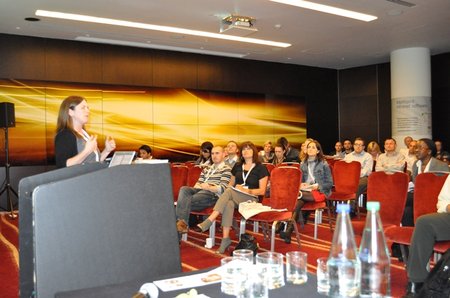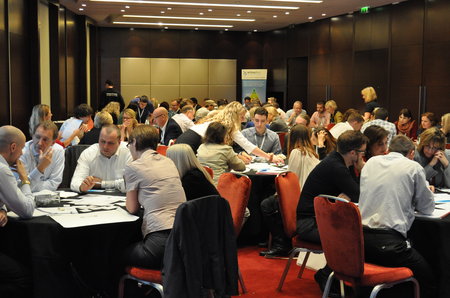Advice from the afternoon speakers at the Interact Intranet Conference
It’s impossible to capture the wealth of ideas and ways of working that were shared at our intranet conference, but I mean to list out some action points for all intranet managers to consider.
Be sure to read the previous article, detailing ideas and actions from the morning speakers; including James Robertson, Mark Morrell and Lee Bryant.
Now, onto some of the afternoon sessions.
Why intranets need to be intelligent – Nigel Danson
Nigel Danson, of Interact, started off by discounting artificial intelligence, but focused on leveraging people’s knowledge and what the intranet knows specifically about the individual. The Interact Intranet system is truly an intelligent platform without actually being Skynet!
Nigel observed that few people go on to the intranet to actively find the company news – the ‘push’ content from the Internal Communications department is not the thing that ‘pulls’ people to the intranet, although it may be relevant. As I cut my teeth on intranets within Internal Communications departments, this hurts me to hear, but it’s the truth isn’t it? Who was it that tweeted “Dear Internal Comms; it’s not all about you. Love, all employees’; I think it was Jonathan Phillips.
Nigel said that the intranet must be essential, rather than something used as a last resort. To become essential the intranet has to be more than useful, it has to be indispensable for the daily tasks, and it has to be trusted. Intranets that allow a mix of business and personal material build trust; enabling people to express themselves and interact socially demonstrates that they are valued and trusted.
Actions
- Refer to your intranet statistics to discover the ‘pull content’ and optimise how people find / access it;
- Customise home pages so that the ‘latest news’ (push content) is relevant to different groups of people;
- Make use of any ‘recommendation engine‘ your intranet has so that content can find people, rather than making people search for content.
Helping the management team find their ‘wow moment’ – Lau Andreason
Lau Andreasen, of J.Boye, encouraged us to change the way we look at our role as intranet managers.
We moan about lack of time and resources – we need to spend ten minutes boasting about the successes we’ve created!
Lau says we should look at the things we can change, the small things, right now, not the next big re-design. Spending thousands of pounds and hundreds of hours developing intranet features / revamping the home page is one way to deliver success, to create business impact, but such major projects can blind us to what we can do right now. I hope it’s OK to share seven ideas I espoused back in 2009, when I was an intranet manager.
Lau says you should enhance what you have now; and that’s a powerful idea because it asks the intranet manager to think creatively and to discover how people need the intranet to support their jobs and tasks. We need to create impact now. Where people struggle, we can find opportunities to help them.
We need to find the ‘killer apps’ of the intranet. Lau doesn’t mean ‘app’ as in ‘smartphone app’, he means the ‘go-to always-used feature / purpose’ of the intranet. We need to find the top tasks that people perform in their jobs and online – what would people miss if the intranet went down for a day, or an hour? Nothing? Then your intranet doesn’t help people. A ‘killer app’ addresses a specific business problem – like a single ‘people directory’ (with search) that helps find people based on name, department or skills.
A ‘killer app’:
- Addresses a specific business problem;
- Brings traffic;
- Promotes the intranet
- Is designed for your organisation;
- Has ‘wow factor’.
Three killer apps
- The Directory – skills, org structure. You need to: Assign ownership of data; Have management lead by example (good profiles); Set update procedures (new starters? leavers?); Consider inclusion in appraisal.
- Idea Management – business ideas and cost savings. You need to: Make submission easy; Have staff rate ideas; Publish follow up – show progress.
- Help & Support – not new build, just making it easy to access, better presentation. You need to: Simplify how people call on support – one page? one number?; Enhance and streamline the options – better presentation.
If you need to secure stakeholder buy-in and approval for making intranet improvements, try filming people using the intranet and their frustrations at intranet failings. Roughly edit it down to two or three minutes and show it to stakeholders. Few people realise how poor the intranet can be for some people.
Actions
- Keep a log that expresses what the intranet team has delivered and what is in the pipeline (six ideas for the six months ahead);
- Focus on benefits and immediate impact;
- Watch (and film?) people doing actual tasks on the intranet – discover how you should optimise things.
Mobile intranets; information on the move – Sharon O’Dea
Sharon O’Dea, of UK Parliament, developed a simple mobile intranet for MPs and lords to use when on the move. Sharon ruthlessly focused on what the users needed when using the mobile intranet. (I’ll say ‘users’ here instead of my customary ‘people’ term, as Sharon absolutely knew who made up the audience.)
Actions
- Have a mobile version of your intranet if you have travelling staff or people who work away from desks;
- Present only the features / services / information necessary – do not replicate or mobilise your entire intranet (I add If you mobile your entire intranet, do not show all of it on the home page or navigation!);
- Focus on eight or fewer ‘use cases’ (how and why a person uses something) or purposes for your mobile intranet;
- Consider location aware services – GPS and maps etc.
 Sharon O’Dea from Houses of Parliament talks at Interaction 2011
Sharon O’Dea from Houses of Parliament talks at Interaction 2011
It was also great to see the home page of the non-mobile parliament intranet as it was quite long and I feel it is wrong to insist that home pages must be entirely presented ‘above the fold’. Home page design is tricky, and priorities must be clear, but scrolling is not evil.
In search we trust – Scott Hitchins
Scott Hitchins, of Interact, succinctly explained that people need to trust the search results. This isn’t about being Google, it’s about delivering results that are specifically relevant to our internal people. The intranet is a known system, rather than a uniquely organic system of systems like the Internet.
Actions
- Frequently and regularly review the search statistics – what are people searching for? What are people failing to find?
- Use ‘best bets’ (like ‘sponsored links) to raise key content up the search results page (rather than gaming the search engine);
- Help people provide you with feedback when they don’t find what they think they should.
How does your intranet search engine learn ? How does it get better? What are you doing to help authors use search engine optimisation techniques for their content?
Planning your next intranet – Chris Attewell
Chris Attewell, of Noko, reminded us that before we plan to develop or improve our intranet, we must be focused on our objective to solve real challenges and help colleagues have a productive day. We therefore have to understand the challenges staff face and the task they undertake, as well as the needs and objectives of the business.
We should not ask people what features they would like on the intranet! It’s our job to understand people’s needs, and that understanding comes from learning the problems people have and the tasks they have to complete. We don’t ask the bare faced question, we discover the requirements.
Chris suggests using personas to help identify challenges and tasks from different areas of the business, and offers his guide to creating personas.
Actions
- Start from people’s needs – not what they say they want
- Aim to meet business challenges and solve problems;
- Develop a small number of personas that explain the challenges and tasks of people.
Check the #iconf hashtag on Twitter (no account necessary) for people’s reactions.
“Really good conference today Interaction 2011 #iconf great insight into the ever evolving ‘digital workplace’, thanks.” ~ Darrin Shaw
There were two streams of talks, and so I missed the following: Ten Worst Practices for Intranets, Sam Marshall; Expose your intranet – Extranet secrets, Nigel Williams, Romec; Customisation vs. Personalisation, James Robertson; Hundreds of intranets don’t lie – patterns of success, Steven Osborne, Interact; Building a charity intranet, Helen Thomas, Clic Sargent; Kickstarting collaboration – focus on pain points, Rooven Pakkiri, Digirati.
Follow Wedge and InteractExperts on Twitter.

